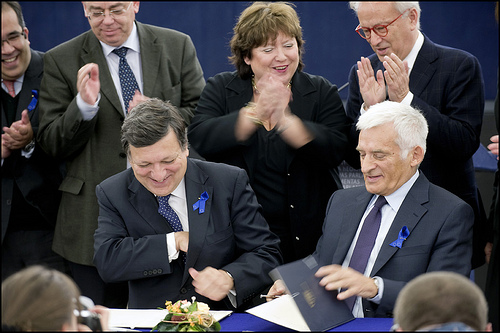The Treaty of Lisbon

Since 2004, the number of EU member countries had grown from 15 to 27 through two waves of "enlargement," as the process is called. To address needed reforms for the larger group and current times, The Lisbon Treaty was signed by all EU Member States on 13 December 2007.
This important treaty "rethinks" some of the ground rules for EU countries working together. It "defines what the EU can and cannot do, and what means it can use. It alters the structure of the EU’s institutions and how they work. As a result, the EU is more democratic and its core values are better served."(Treaty of Lisbon, Taking Europe into the 21st Century) The Treaty went into effect on 1 December 2009.
The Treaty opened the door for many new opportunities for the EU to work together, including areas related to the environment and energy.
"The Treaty of Lisbon states that one of the Union’s objectives is to work for the sustainable development of Europe based, in particular, on a high level of protection and improvement of the quality of the environment. Although the idea of sustainable development was included in the existing treaties, the Treaty of Lisbon reinforces and better defines this objective. Sustainable development is also affirmed as one of the fundamental objectives of the Union in its relations with the wider world.
The environment is one of the spheres of competence shared between the Union and the Member States. When the Union intervenes in this area, it must contribute to the pursuit of clear objectives: preserving, protecting and improving the quality of the environment; protecting human health; promoting prudent and rational utilisation of natural resources; promoting measures at international level to deal with regional or worldwide environmental problems.
Climate change is among the biggest environmental, social and economic challenges currently facing mankind. With the Treaty of Lisbon, combating climate change on an international level becomes a specific objective of EU environmental policy. The Treaty of Lisbon adds the support of international action for fighting climate change to the list of objectives defining environmental policy at EU level. In so doing, the Treaty clearly recognises that the EU has a leading role to play on the world stage in this area.
(Treaty of Lisbon, Questions and Answers, retrieved October 2011)
The Treaty also contains "a specific chapter on energy which defines the key competencies and the overall objectives of energy policy: the functioning of energy markets, security of supply, energy efficiency and savings, the development of new and renewable forms of energy and the interconnection of energy networks. For the first time there is a principle of solidarity, ensuring that if one country faces severe difficulties in the supply of energy, other Member States will help keep the country supplied." (Europa, Policies for a better life, retrieved October 2011)
To Read Now
Important EU policies and programs related to energy and the environment
- EU-ETS The EU Emissions Trading System operates by the allocation and trading of greenhouse gas emissions allowances throughout the EU - one allowance represents one tonne of carbon dioxide equivalent. From the European Commission Climate Change, read European Union Emissions Trading System
- 20-20-20 From the European Commission Climate Change, read The EU Climate and Energy Package
- The SET-Plan (Strategic Energy Technology Plan) From the European Commission, read Overview and What is the SET-Plan
